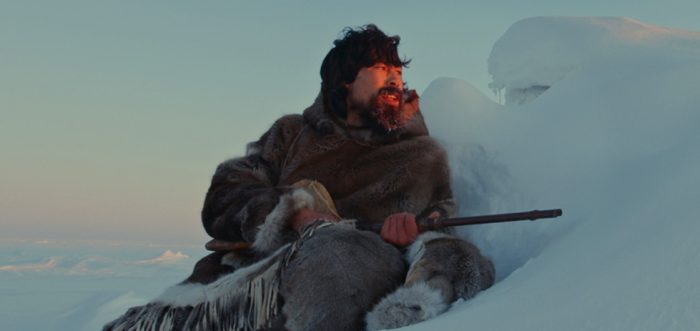
The struggle of onscreen representation for the Inuit is, as to be sadly expected for an indigenous population, a perilous and ongoing one, riddled with ribald misrepresentations and regular old colonialist erasure. You’d be forgiven, if asked to name the most famous Inuk to grace the screen, for thinking right back to Nanook and his adventures in northern Quebec. Half-fact, mostly fiction, Robert Flaherty’s technically groundbreaking 1922 docudrama is responsible for a certain stereotype of the Inuit that still holds strong. It’s not so much in content that Flaherty’s film subtly patronizes than the way it’s propagated — the poorly aged ethnographic narrative framing that belittles Nanook and his kin by fetishizing his cultural practice, creating an imaginary western vision of the humble “Eskimo” as a survivalist hero of the Arctic.
Since the silent days of creaky anthropologies and exoticised adventure stories, an unhealthy undercurrent of colonialist conquest has buoyed the major American genres: in the jazz influence of the insidiously white Hollywood musical or the outright racism of the Amazonian adventure tale, and perhaps nowhere more ubiquitous than in the Western. With its oft-painted ‘Indians’, with rare exception bloodthirsty savages, the oater thrived on racial oppositions, its sympathies more often than not on the side of white frontiermen. It’s with this deluge of context in mind that Zacharias Kanuk — most famous for the Camera d’Or-winning Atarnajuat: The Fast Runner, the first ever feature entirely in Inuktitut — has set about loosely remaking the most widely adored of the American Westerns, John Ford’s The Searchers, as an all-Inuit revenge tale.
It’s an exercise that, from the premise alone, might seem conceptually ripe for a combatant anti-colonialist rebuke, but Kanuk and co-director Natar Ungalaaq’s methodology is surprisingly composed and non-confrontational. Narrowing the cast down to a few key roles and replacing the racial conflict of the original with an inter-indigenous journey of retribution, Maliglutit (“Searchers” in Inuktitut) is significantly driven by the need to preserve and protect native traditions. Kanuk used the production as a practical exercise in community development: elders consulted on production and art direction, instructing young actors on traditional hunting, cooking and igloo construction; the costumes were individually made of animal furs and hides to meet the actor’s dimensions, measured with string and hand-sewn; traditional throat singing enhances an already evocative soundtrack.

The value of this authenticity to the story can’t be overstated — it’s warmly observational, with an obvious sense of pride in tradition, without being forthrightly ethnographic — but Kanuk knows not to foreground it. He doesn’t eschew plot or propulsion for detail, but rather slowly introduces dramatic elements after taking his time to establish a steady, quotidian clip. It’s the interruption of this peaceful way of life that kicks Maliglutit into gear. When the story begins proper, with the brutal kidnapping of Tagaaq (Karen Ivalu) and her daughter Ailla (Jocelyne Immaroitok) by a horde of vagrants whilst husband Kuanana (Benjamin Kanuk) and son Aulla (Jonah Qunaq) hunt caribou, over 40 minutes into its short runtime, it feels like a real and invasive disruption. The subsequent quest to retrieve and avenge outperforms The Revenant in the snowy restitution stakes, exercising sheer production grit and a spectacular formal control over the film’s few simple elements.
That it’s set in 1913 — nine years before Nanook and 45 after Ford’s Civil War-set The Searchers — isn’t at all evident, barring the ongoing presence of a set of binoculars and the late appearance of a rifle. The film has a peculiar, culturally specific relationship with time, influenced no doubt by the far north’s extreme location and its eternal days and nights. Time passes not with the tremendous moil of quote-unquote Slow Cinema but with a more purposeful and observatory slowness. Men untangle sled hounds and women sew; discussions of courtship and the spirits between kin take place in igloos aglow with a warm oil lamp; a caribou hunt and the humble feast that follows consumes much of the first half-hour of the film. Pace seems intertwined with environment — the vast terrain and hyperthermic temperatures restrict speed. You can spot the frost bite on the actors better than you can the horizon, where white ice meets the blinding glare of the sky, and the fact that cinematographer Jonathan Frantz’s camera is reticent to move is understandable — at -48°C, it barely can.
There are proven methods of battling representational racism and colonialism — with bitter resistance and scathing retaliation, of course, but also, as Kanuk here proves, with the unruffled and constructive tools of original storytelling. Plucking John Ford’s evergreen Western from its place atop the canon, Kanuk has dismantled it to bareness and retold it with the specificity of his own cultural experience. Perhaps his most radical revisionist gambit is the decision to reshape the story’s conflict, and by extension its entire subtext — by scrapping the racial conflict he subtly demolishes the binary archetypes to which indigenous peoples have been held since screen immemorial. No more good Nanooks and bad Comanches, just good and bad and the infinite shades between. Maliglutit might not be the rollicking high-energy masterpiece of its predecessor, but its value lies elsewhere, in its meticulous preservation of an endangered lifestyle and its perspective of the moral poles from the isolation of the northern plains, unsullied by the grot of America’s cultural imperialism. At its best, it feels fresher than an Arctic breeze.
